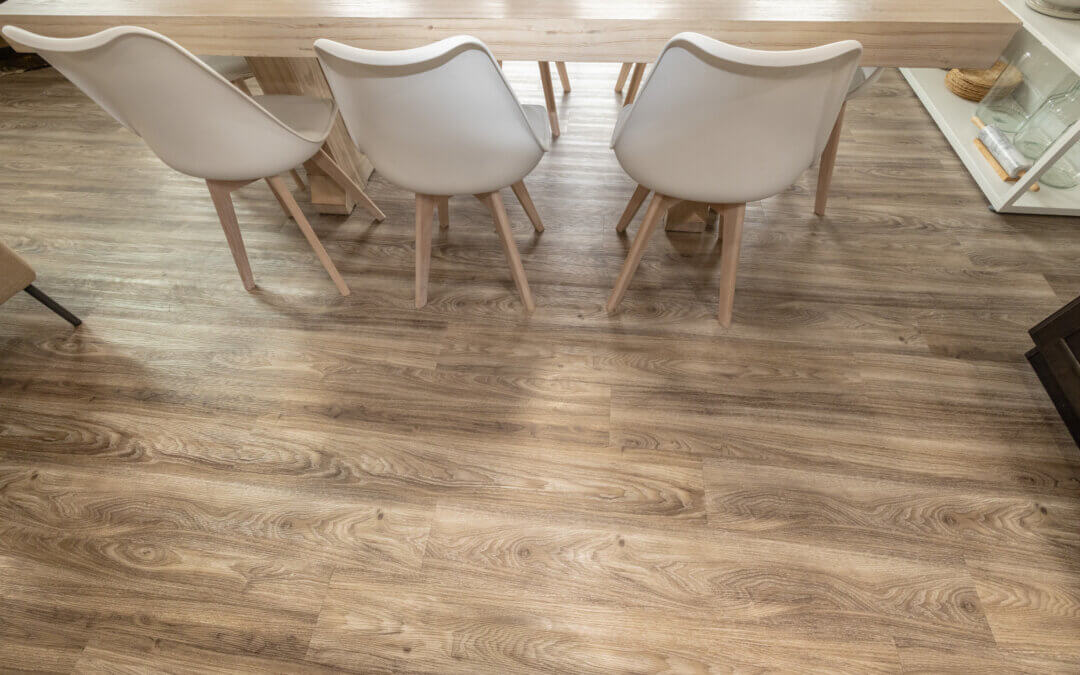Make Your Kitchen Floor Ideas Happen
If you’re looking to make your kitchen flooring ideas come alive, you’ve come to the right place! We know how challenging it can be to decide on the best option for your home. Whether you’re debating between wood, tile, laminate, or vinyl there are so many wonderful choices available that the decision-making process can certainly be daunting. Fortunately, we’ve got all of the tips and tricks you’ll need to make your new kitchen floor ideas a reality! Keep reading for some helpful advice on finding the ideal kitchen flooring.
Things to consider before selecting your Kitchen Flooring
There are important factors to consider while exploring your kitchen flooring ideas. You should do your research before purchasing products because it is a significant investment, and the flooring you choose will have a significant impact on the appearance, comfort, and functionality of your space. Here are a few things to think about as you begin to browse different flooring for your kitchen space:
Budget:
You should consider your budget and how much you are willing to spend on flooring materials. Different types of flooring have varying prices, so it is important to choose one that is within your budget.
Durability:
The durability of the flooring materials is an important factor to consider. You should think about how much traffic the kitchen flooring will receive and choose an option that can withstand it.
Maintenance:
You should consider how much maintenance the kitchen flooring will require. Some types of floors are easier to clean and maintain than others.
Style:
You should consider the style of your home and choose flooring materials that complement it. Different types have different styles, so it is important to go with the best kitchen flooring ideas that match the overall aesthetic of the home.
Comfort:
You should consider the level of comfort that the floor will provide. Some types of flooring material are softer and more comfortable to walk on than others, which may be important if the kitchen floor will be used frequently.
Types of Flooring Materials
There are many different types of kitchen flooring because different materials offer different benefits and are better suited for different environments, styles, and budgets. Although appearance and style are very important when considering your kitchen flooring ideas, there are other factors to consider as well. We’ve compiled some facts about each type of kitchen flooring material you may encounter to help you select the best options for your floor project.
Luxury Vinyl Flooring
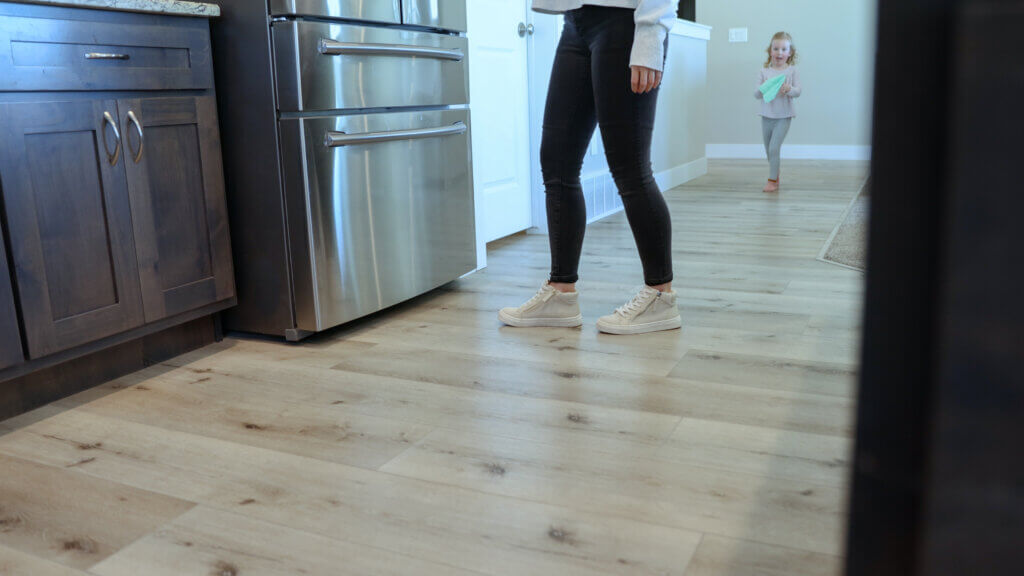
There are two popular types of luxury vinyl flooring available, each with its own unique characteristics and benefits. Both options would be a great choice for your next kitchen floors.
Luxury Vinyl Plank (LVP) flooring mimics the look of a hardwood floor with realistic wood textures and embossed grain patterns. LVP is typically available in a variety of colors, plank widths, and lengths, making it a versatile option for any floor.
Luxury Vinyl Tile (LVT) flooring mimics the look of natural stone or ceramic tile with a variety of patterns and textures. LVT is available in a wide range of colors and sizes, and it can be arranged in various patterns to create a unique looking floor for any design style.
Pros of Luxury Vinyl
Luxury vinyl tile and luxury vinyl plank flooring have a lot of pros that make them a popular choice among homeowners. They are affordable compared to natural materials like hardwood floors or natural stone while still providing a high-end look. They are also a highly durable floor, resistant to scratches, dents, and water damage, making them ideal for high-traffic areas and homes with pets or children. Their mimics of natural grain make them a beautiful alternative to wooden flooring.
LVT and LVP requires minimal maintenance, with simple cleaning to clean up spills or dirt. Vinyl flooring comes in a wide variety of colors, patterns, and textures, making them a versatile option for any decor style. LVT and LVP have a soft, cushioned feel underfoot, making them more comfortable to walk on than other materials like stone or ceramic tile.
Overall, LVT and LVP flooring are an excellent choice for homeowners who want a stylish and durable option that is easy to maintain and install at an affordable price point.
Cons of Luxury Vinyl
There are some cons to consider before choosing LVP or LVT. While LVP and LVT claim to be scratch resistant, it is still a possibility to scratch these products. These products also have potential for fading or discoloration over time, especially spots that are exposed to direct sunlight for long periods of time.
LVP and LVT products may not be as eco-friendly as natural materials like hardwood or stone, as they are typically made from synthetic materials.
Laminate Flooring
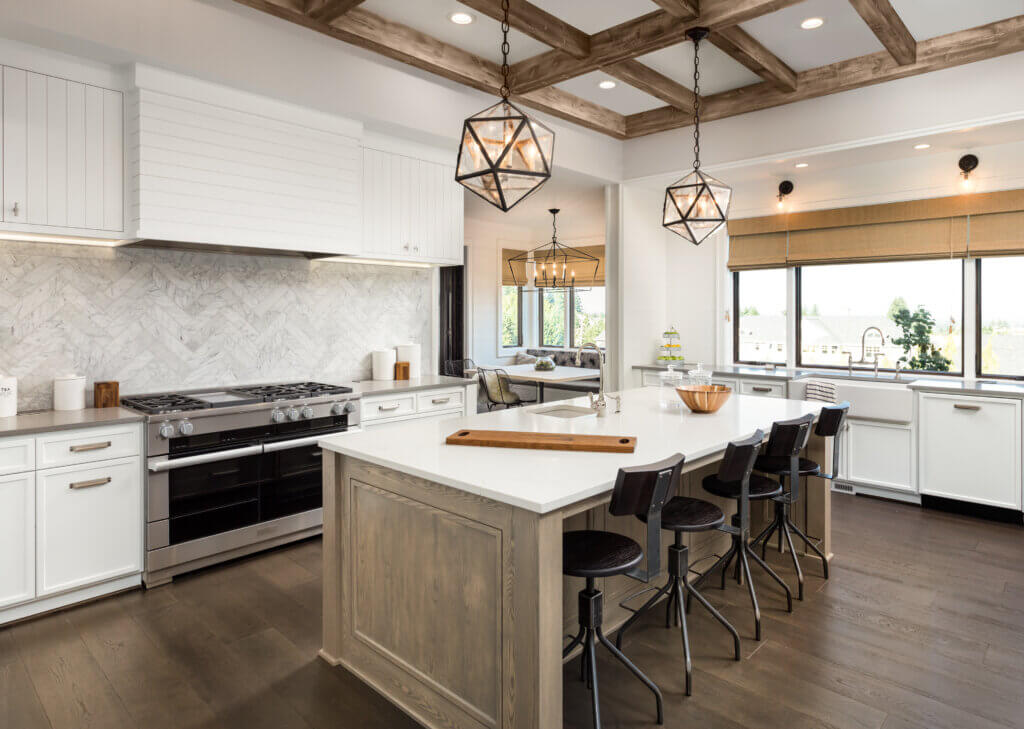
High-pressure laminate (HPL) is made of multiple layers and is known for its durability, while direct-pressure laminate (DPL) is a more affordable option suitable for most residential applications. Embossed-in-register (EIR) and hand-scraped laminates feature textured surfaces that mimic the grain and texture of real wood, while distressed laminates have a weathered appearance. Smooth laminates have a flat surface without any texture or pattern. This could be used in a modern kitchen or dining area.
With such a wide range of options available, it’s easy to find the perfect laminate options for your kitchen flooring.
Pros of Laminate Flooring
This kitchen flooring can be an excellent choice for a floor due to its durability, ease of maintenance, and affordability. Kitchens are often high-traffic areas that are prone to spills, stains, and scratches, and a laminate floor can withstand these challenges.
A laminate floor is also easy to clean and maintain, requiring only regular sweeping and occasional mopping. It is also an affordable alternative compared to hardwood or tile flooring, making it a popular choice for those on a budget.
This kitchen flooring also comes in a wide variety of styles and colors, so it’s easy to find a look that complements your kitchen decor.
Cons of Laminate Flooring
One drawback of this floor is that it can be prone to water damage if not installed and maintained properly. If water seeps between the laminate planks, it can cause the material to swell and warp, which can be difficult to repair. This can be a problem for kitchen flooring that sees a lot of spills or too much moisture during cleaning.
While a laminate floor is durable, it can still be prone to scratches and chips, which can detract from its appearance over time.
Also, while this kitchen flooring is available in many styles and colors, it may not provide the same level of design flexibility as other materials, such as tile or hardwood flooring.
Tile Flooring
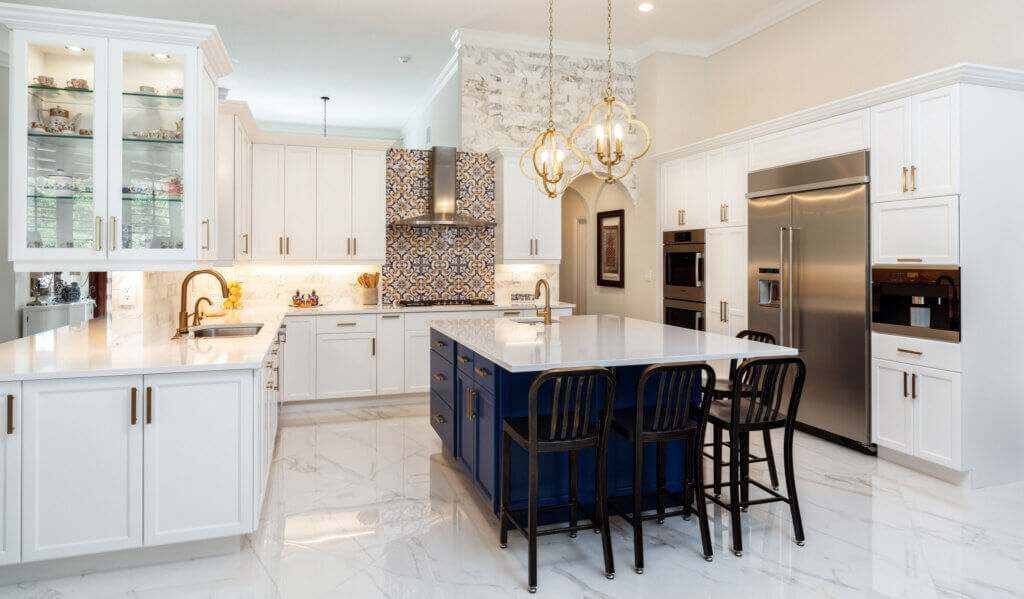
Ceramic tiles are made from natural clay that is fired at high temperatures and are known for their affordability, wide range of colors, patterns, and textures, and suitability for high-traffic areas.
Porcelain tiles are made from fine, dense clay that is fired at higher temperatures than ceramic tiles, making them highly durable, water-resistant, and low-maintenance.
Natural stone tiles, such as marble, granite, limestone, and travertine, offer a unique, luxurious look that can be customized to fit a variety of styles.
Each of these floor tiles has its own advantages and disadvantages, making it important to consider factors such as durability, maintenance requirements, and cost when selecting the right tile for your kitchen flooring.
Pros of Tile Flooring
This option is a popular choice for a kitchen or dining room floor for several reasons. First and foremost, tile is extremely durable and can withstand heavy foot traffic. It also resists stains, spills, and drops without showing signs of wear and tear. This is especially important for the kitchen flooring, where spills and stains are common.
Floor tiles are also easy to clean and maintain, making it a hygienic as they do not harbor bacteria, mold, or dust mites making ceramic floor tiles a great option for food preparation areas. Ceramic tiles, along with other stone floors are also fire-resistant. You may also choose this tile because it is available in a wide variety of styles, colors, and patterns, which means that it can complement any decor style.
Floor tiles are a timeless material that will never go out of style, making it a sound investment in the long run.
Ceramic or porcelain tile can add value to a home, as it is a sought-after feature for potential buyers. This tile would also be a great option to choose for underfloor heating.
Cons of Tile Flooring
There are some potential downsides to consider, including the hardness of the surface, slipperiness, the need to clean grout lines, difficulty of installation, can be cold underfoot, and higher cost compared to other types of floor materials.
Wood Flooring
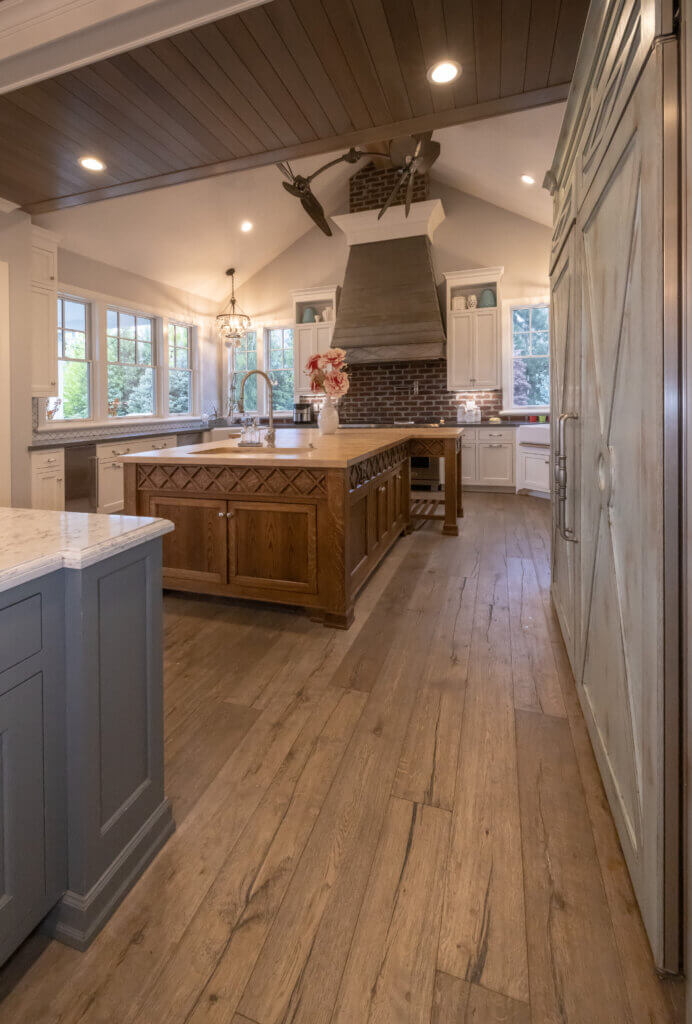
There are several different types of this option available as hardwood kitchen flooring has become more popular.
Solid hardwood flooring is made from a single piece of hardwood and is known for its durability and timeless beauty.
Engineered hardwood flooring is made from multiple layers of wood that are bonded together, creating a stable and durable product that is less prone to expansion and contraction than solid hardwood floors.
Pros of Wood Flooring
Wood flooring can be an excellent choice for a dining room or kitchen flooring due to its durability, warmth, and timeless beauty.
Solid hardwood flooring is known for its durability, and with proper care and maintenance, it can last for decades.
Engineered hardwood flooring is also a great option for kitchens as it is more resistant to moisture and temperature changes than solid hardwood.
Wood flooring can add warmth and natural texture to a kitchen, making it a cozy and inviting space.
A wood floor can complement a variety of design styles, from traditional to modern. While it may require a bit more maintenance than other flooring options, such as tile or laminate, wood flooring can be refinished and re-stained over time to maintain its beauty and durability.
Cons of Wood Flooring
While a wood floor can be a beautiful and durable choice for a kitchen, there are some reasons why someone may choose not to use it in this space. One drawback of wood flooring is that it’s wood veneer can be susceptible to water damage if not properly sealed and maintained. Spills and moisture can seep between the wood planks, causing them to warp and potentially lead to mold growth.
Wood flooring can also be prone to scratches and dents from high-traffic and heavy use areas in the kitchen.
Lastly, wood flooring may require more maintenance than other options, such as tile or laminate, as it needs to be cleaned and resealed periodically to maintain its appearance and durability.
Before You Choose Your Perfect Floor
Overall, when choosing kitchen flooring, there are many great options out there. Make sure to consider how durable the flooring is before making a decision, as well as how much maintenance it will require and if it will fit your budget. Furthermore, you’ll want to understand its impact on the overall aesthetic of your kitchen design. After all, you want the space to be comfortable and inviting for everyone who gathers around the table in your home. So look at sample boards with both dark and light tones that match furniture or walls for an idea of how different floor materials look in a real-life setting. By considering these factors, you’ll be better prepared to choose the best kitchen flooring in order to create a stunning atmosphere in your home that is unique to you and your family’s needs.



